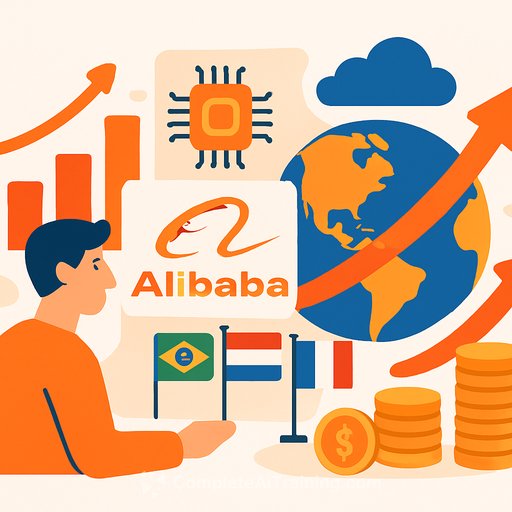Alibaba Lifts AI Budget Past $50B: What Executives Should Do Next
Alibaba signaled an aggressive AI push, setting plans to exceed its original 380 billion yuan ($50B+) commitment for models and infrastructure. CEO Eddie Wu expects global AI investment to hit roughly $4 trillion over the next five years and is moving to keep pace.
The company plans new data centers in Brazil, France, and the Netherlands, and is rolling out Qwen models with a full-stack approach that includes chips, compute, and networking. The market response was decisive: Alibaba rose up to 9.7% in Hong Kong, while Chinese chipmakers ACM Research (Shanghai) and Naura gained 15% and 10% respectively.
Why this matters for strategy
- Demand signal: Alibaba's increased spend suggests enterprise appetite for AI infrastructure is expanding faster than expected. Triple-digit growth in AI products and a 26% jump in cloud sales support that trend.
- Global footprint: New data centers across Latin America and Europe mean lower latency, data residency options, and more local compliance coverage for multinational deployments.
- Model choice: Alibaba launched Qwen3-Max and continues to broaden services, giving buyers another option alongside US and Chinese peers.
- Investor sentiment: Big names are rebuilding positions, reflecting confidence that heavy AI capex will pay off over time, even amid questions about near-term profitability.
- Competitive intensity: China's tech giants (Alibaba, Tencent, Baidu, JD.com) could spend $32B on AI in 2025 vs. ~$13B in 2023. The arms race is accelerating on both sides of the Pacific.
Key constraints and geopolitics
Access to advanced Nvidia processors remains uncertain due to US export controls. Beijing is also pushing firms to reduce reliance on Nvidia workstation GPUs. Alibaba is investing in its T-Head accelerators and integrating Nvidia development tools into its cloud to bridge capability gaps.
For global buyers, this means vendor concentration risk is real. Diversification across clouds, regions, and chip supply paths is moving from nice-to-have to required.
For context on US controls, see the Bureau of Industry and Security updates here.
Execution playbook for the next 90 days
- Portfolio audit: Identify top AI workloads by value, sensitivity, and latency needs. Map them to regions where Alibaba is expanding (Brazil, France, Netherlands) to improve user experience and compliance.
- Sourcing strategy: Run a structured bake-off across Alibaba, US hyperscalers, and regional providers. Compare GPU availability SLAs, per-token costs, and egress pricing.
- Chip risk plan: Include clauses on GPU allocation, transfer rights across regions, and fallbacks to CPU/alternative accelerators. Set thresholds to auto-shift workloads if queue times or failure rates spike.
- Model governance: Test Qwen3-Max and at least two other LLMs for your use cases. Track accuracy, latency, prompt sensitivity, and safety responses by domain.
- FinOps discipline: Treat AI like a trading book. Daily cost dashboards, unit economics per feature, and auto-throttling for non-critical inference.
- Data policy: Lock down PII flows. Use regional stores and encryption by default; apply retrieval-augmented generation for sensitive contexts.
- ROI proof points: Define two metrics per use case (e.g., time-to-resolution, revenue per agent-hour). Scale only after hitting thresholds for two consecutive sprints.
- Team upskilling: Stand up role-based enablement for product, data, and engineering. Curated, job-focused programs can speed adoption here.
Signals to watch
- Infrastructure: Launch timing and specs of new Alibaba data centers; GPU types, networking fabric, and committed capacity.
- Model performance: Independent benchmarks for Qwen3-Max versus peers on enterprise tasks (retrieval, structured output, tool use).
- Customer traction: Named wins in regulated sectors and multi-region rollouts, a leading indicator for enterprise confidence.
- Chip ecosystem: Progress of T-Head accelerators, third-party validations, and any joint offerings with local fabs or integrators.
- Policy shifts: Changes to US export controls or Chinese procurement guidance that affect GPU supply and cross-border services.
- Financial posture: Alibaba's free cash flow and capex cadence after a recent $2.6B FCF outflow as quarterly capex tripled to 38.6B yuan. Watch whether AI spend converts to durable gross margin uplift in cloud.
Competitive context
China's majors are pressing ahead with proprietary models and services: Tencent's Hunyuan, Baidu's Ernie, and Alibaba's Qwen family. This broadens vendor choice for enterprises, but also fragments standards and support models across regions.
Market reaction remains strong, yet some analysts argue near-term earnings may lag sentiment, with internally focused strategies potentially showing clearer returns. Treat market gains as a signal, not a guarantee.
Bottom line for executives
AI spend is consolidating around vertically integrated stacks-models, chips, data centers, and ecosystem tools. Alibaba's bigger bet reinforces that direction.
Respond with optionality. Diversify suppliers, design for portability, and prove ROI in weeks-not quarters. The winners will be the teams that standardize on measurable value and move capacity to where it performs best.
Your membership also unlocks:






